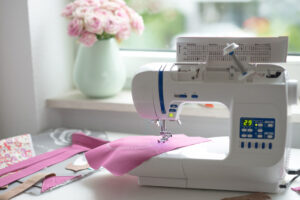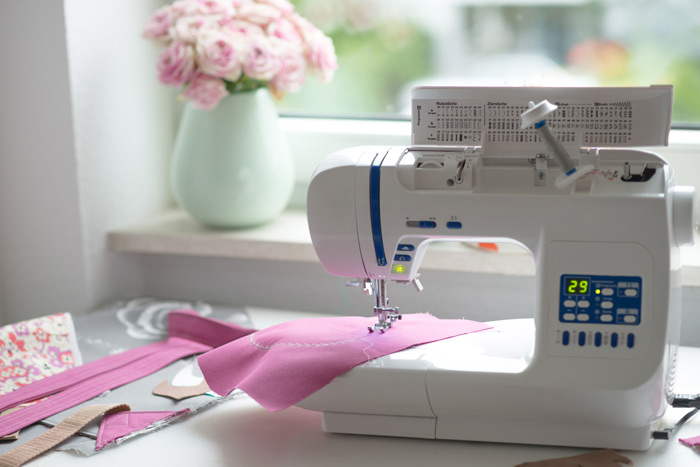 Even if you’re not an avid sewer, it’s good to have some basic knowledge about the parts of a sewing machine.
Even if you’re not an avid sewer, it’s good to have some basic knowledge about the parts of a sewing machine.
You should know about all the major components of sewing if you want to work with different models.
Some of the reasons why you should know the functions of basic parts as well are:
- Easy to get familiar with different models.
- I can easily troubleshoot if any problems come up.
- Have a better knowledge of sewing mechanics
- Easy to spot a good sewing machine
Main Parts of a Sewing Machine
Although there are different kinds of sewing machines that are available in the market, the major components involved in them and the significant mechanics are almost all the same.
So, once you get to know the essential components of it, you won’t take long to figure out other models.
So, below we will be looking at all the major parts involved in a typical sewing machine, and I will also be mentioning their main functions along with them to grasp the concept.
1. Power Cord / Switch
Unarguably, these are the most critical parts of the sewing machine, as, without any power, a device cannot possibly run.
However, there are some mechanical machines as well, which can run without power, but since they involved a lot of human effort, they are not very common nowadays and have become pretty obsolete.
2. Hand Wheel
This is a round-shaped wheel type of thing whose job is to move the needle up and down depending upon the fabric position. Without the handwheel, it will become pretty hard to get the fabric in the right position under the needle.
3. Foot Pedal
This is also something that is not present in a purely mechanical sewing machine.
Still, since nowadays, most of the devices are electrically powered, this is considered to be a significant power, and it is essential in controlling the speed of the machine.
More the stress you put on this pedal, the higher the speed machine achieves.
4. Spool Holder
This is a small pin-type structure on the top of the sewing machine where the spool of thread is attached. The spool keeps on rotating, with the thread being unwound as you work.
5. Pattern Selector
Pattern selector is where you have to select the type of stitches you need to make on the fabric. Some sewing machines offer many patterns that you could use, while some have the option of only a few.
You can mostly stitch straight, zigzag, embroidery stitches, and so on. However, if you have an old machine, it may not offer any options and stitch straight.
6. Stitch Length Adjustment
It refers to the length of the stitches, and setting it according to your project needs is very important. The smallest length you can set is 0, while the longest is 4.
You can set the value between these two anywhere as you like—basically, more the length, more the length of fabric fed under the presser foot.
7. Bobbin Winder
Bobbin Winder, the component used to wrap the thread around the bobbin, and without it, you would have a tough time winding the thread around the bobbin.
If you don’t know where the bobbin is, it will be located on the top or right side of the machine. If you see a small spool of thread there, that would be the bobbin right there.
8. Tension Disks
These are the disks responsible for adjusting the tension in the thread, and it’s another essential component. If it fails to function properly, it could even jam the machine, and fixing it would be another story.
There are different types of tension disks and their controls nowadays. Some modern machines come with dials to control the tension, and some are direct devices, while some are indirect.
However, the essential machinery is the same. Both these contain the spring, thumb nut, mounting bar, and lastly, the pressure releasing unit.
9. Needle / Clamp
Even beginners know about the importance of the needle, and it’s the main thing responsible for actually sewing the fabrics. Once it is attached to the thread, you’re good to go.
Another major part attached to the needle is the clamp, which holds the needle in its place.
Make sure you adjust the needle completely with its clamp to let it function properly.
10. Feed Dog
Next up, we have a critical component, which is amongst the essential parts of the sewing machine.
If you look closely under the needle of the sewing machine, you will notice some teeth-like structures; those are the feed dogs.
What they do is that they fetch the fabric and pull them so they could keep on getting fed to the needle. Another primary job, which is also the responsibility of the feed dog, is regulating the stitch length.
11. Presser Foot
Presser’s foot ensures that the fabric is hardly pressed upon from the top counter to the feed dog.
Feed dog is the component responsible for the moving of the fabric under the needle, and the job of this presser foot is to apply the downward pressure to the fabric being fed to the needle.
In case the presser foot goes wrong, the needle would have a hard time taking in the fabric even if the feed dogs are working fine.
If the fabric doesn’t come well under the needle, make sure you look at the presser foot as the potential problem and not just the feed dogs.
12. Face Plate
This is quite a basic but essential part of the sewing machine. The faceplate is merely the cover of the machine, which makes all the internal parts of the machine abstract to our eyes.
If not for the faceplate, we would see all the mess in front of our eyes.
13. Throat Plate
The throat plate is also kind of a cover; however, it is the cover on top of the bobbin and a small compartment below the feed dogs of the sewing machine.
The compartment could act as a mini-storage area for small things needed while sewing.
Moreover, if you need to fix the bobbin, you will need to uncover the throat plate and take the bobbin out.
14. Sewing Light
Again, a very basic but important part is the sewing light. If you don’t work in the dark or at night, you might see the light as a useless thing.
However, many people work at night or don’t have ample light around all the time to work properly. Sewing is a delicate task, and lighting is a necessity.
All this makes the presence of the sewing light very crucial.
15. Thread Cutter
Thread cutters are located behind the needle of the sewing machine so that once you are done with the sewing job or a part of it, you can conveniently cut the thread off to mark the end of the segment.
However, most modern machines nowadays have automatic thread cutters, so you may not need to worry about it.
But if you have an old machine, the thread cutter needs to be in good shape at all times; otherwise, sewing will become a very annoying job for you.
16. Bobbin and Its Case
The bobbin is a small spool of thread located at the bottom and has a case covering it.
Inside the case, there is a bobbin winder, and the important point to note here is that the thread needs to be wound evenly on the bobbin if you want your machine to function normally.
Otherwise, the handwheel may sometimes get hard to turn. Other than that, you only need to make sure the bobbin is properly fixed inside its case.
17. Slide Plate
This is the cover for the bobbin and resides near the throat plate.
The sole purpose of this compartment is to house the bobbin case inside of it, and if you need to take out the bobbin anytime, you will have to open this plate and take it out.
Conclusion
A sewing machine is a very important tool and one of the most important things in everyday lives, even if we don’t realize it.
All the garments we wear everything are designed and made thanks to this piece of machinery.
While you may not be an expert on the sewing machine, it will still be very useful for you to get to know its basic components making it work.
There are different kinds of machinery out there, but the basic parts and the mechanism are all the same.
So, this article will provide you a brief intro to all the major parts involved, irrespective of what specific model you use or may use in the future.
Read Also:

